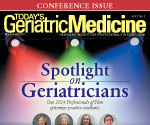 |
 |
Research has shown that insufficient vitamin D intake among older adults contributes to osteoporotic fractures. A recent study shows an association between long-term low vitamin D intake levels and an increased 10-year fracture risk in elderly women. The study also indicates a significantly lower incidence of hip fractures within 10 years in women whose vitamin D intake reached adequate levels. Researchers have concluded that increasing older adults’ vitamin D intake could reduce their falls and fracture risk.
In addition to reading our e-newsletter, be sure to visit Today’s Geriatric Medicine’s website at www.TodaysGeriatricMedicine.com, where you’ll find news and information that’s relevant and reliable. We welcome your feedback at TGMeditor@gvpub.com. Follow Today’s Geriatric Medicine on Facebook and Twitter, too.
— Barbara Worthington, editor |
 |
 |
Research Shows Impact of Long-Term Vitamin D Insufficiency
on Fracture Risk
A study presented in April at the World Congress on Osteoporosis, Osteoarthritis, and Musculoskeletal Diseases shows that long-term low levels of vitamin D intake are associated with a higher 10-year fracture risk in elderly women.
Vitamin D insufficiency in older adults has been shown to contribute to an increased risk of osteoporotic fractures. Previous studies have used single vitamin D measurements to investigate effects on bone. However, in elderly women, relatively little is known about the effects of long-term vitamin D insufficiency on bone health.
The study by Swedish researchers used sequential assessment of serum vitamin D to determine whether sustained hypovitaminosis D in elderly women leads to increased 10-year fracture incidence.
Study participants at baseline included 1,044 75-year-old Swedish women, with 715 attending the five-year follow up. Serum 25-hydroxyvitamin D [25(OH)D] levels were classified as low (< 50 nmol/L), intermediate (50 to 74 nmol/L) and high (> 75 nmol/L). Women with values in the same 25(OH)D category at both samplings were considered to have consistently low, intermediate, or high levels. Fracture data were followed for 10 years through X-rays.
Full story » |
 |
 |
Diet’s Link to Longevity
Does caloric restriction result in extended life span? According to an article in The New York Times, the jury is still out.
Too Much Exercise Could Be Bad for Your Heart
An article in the St. Paul Pioneer Press suggests too much exercise could damage the heart.
Senior's Rape Throws Light on Problems in Assisted Living
Assisted-living facilities appear subject to inadequate regulation and offer limited accountability, according to an article in the Minneapolis Star Tribune.
Frozen Feces, Nose Tubes May Ease Fecal Transplants
Fecal transplants to treat Clostridium difficile may be streamlined by the use of frozen feces, according to an article in USA TODAY. |
 |
 |
Have a product or service you want to market to geriatricians, other physicians and the geriatric care team of professionals who treat aging patients? Are you a recruiter looking to fill the many geriatric professional openings within a facility, physician practice or academic institution? Then utilize the reach of Today's Geriatric Medicine to accomplish your marketing goals and fill any open positions.
A resource for professionals looking for new opportunities, as well as those physicians just curious to see what's out there, our Physician Recruitment Center gives physician recruiters a powerful tool to fill partnership opportunities, academic appointments, and hospital staff positions. To support your product marketing or recruiting needs, e-mail our experienced account executives today at sales@gvpub.com for more information or call 800-278-4400! |
 |
|
|
 |
The Role of Vitamin D in Falls:
Q & A on the AGS Consensus Report
Experts provide guidance on vitamin D supplementation. Read more »
Applying New Obesity Guidelines
Physicians are challenged to step up their efforts to identify patients who are obese and counsel them regarding weight loss thanks to new guidelines released in November 2013. Read more »
Sexuality and Dementia
Administrators and medical directors in long term care facilities should formulate policies to address concerns related to sexual behaviors in dementia patients. Read more » |
 |
 |
The MAP System
The MAP System by Wellsense uses a continuous pressure-mapping system to monitor the functionality and appropriateness of selected support surfaces for individual patients. Real-time visual feedback on the interface pressure between a patient and the support surface enables caregivers to act promptly on identified areas of high pressure. Learn more »
The V-Go
The V-Go delivers insulin at a continuous preset basal rate and on-demand bolus dosing for adults with type 2 diabetes requiring insulin. It works with no electronics, batteries, infusion sets, or programming. The small, lightweight device worn under the clothing measures just 2.4 X 1.3 X 0.5 inches and weighs approximately 1 oz when filled with insulin. Learn more » |
 |
 |
 |
A Secure, Anonymous Résumé Bank
Job Alerts Sent to Your E-mail |
 |
 |
Have a question you want answered by one of our experts? Send your question to TGMeditor@gvpub.com and it may be featured in an upcoming e-newsletter or print issue.
|
 |
 |
 |
Set up Job Alerts and create your online Résumé
to let potential employers find you today! |
 |
|


